Hello.
This is Lab Companion of JeioTech.
Recently, research on life science has been conducted more actively due to the COVID-19 pandemic. Clean Bench is a device designed to continuously flow clean air that has been filtered through the interior space of the workbench and is mainly used to protect samples or products on the workbench from fine dust, bacteria, and mold and to prevent cross-contamination between samples.
Clean Bench is a necessary equipment for experimenting with various microbial cultures, plant and animal cell culture, plant and animal tissue culture, and nude mice that are vulnerable to contamination and infection. It is one of the essential equipment in a life science research laboratory and prevents external pollutants from entering because the clean air generated from the upper part is discharged through the inside of the workbench in the direction of the worker (outside the sash).
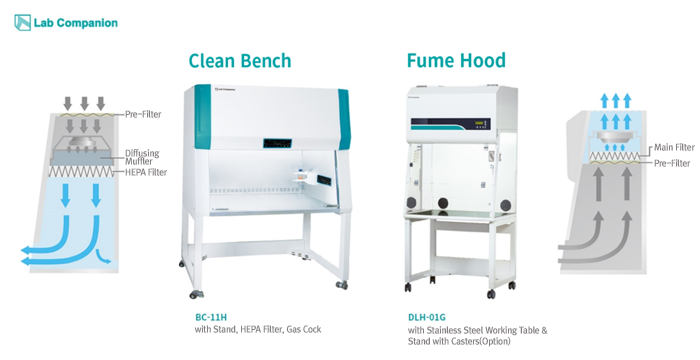
Here is a brief introduction to another workbench called Fume Hood. Unlike having a similar appearance to a Clean Bench, a Fume hood sucks air from the outside of the sash where the worker is located into the inside to collect harmful gases generated during the experiment and discharges it through a duct or filter. Please choose the suitable workbenches depends on your use. Use a Clean Bench when culturing cells or strains, and use a Fume Hood when handling hazardous chemicals or hazardous substances for workers.
01. Precautions for using Clean Bench
- Please sterilize with a UV lamp before starting. Various bacteria and viruses other than E-coli are sterilized upon irradiation for more than 30 minutes.
- Please be sure to turn off the UV lamp before working. If turned on with a fluorescent lamp at the same time, it may not be recognized, resulting in severe burns to the skin.
- Clean Bench does not protect the user from the sample. When using a sample that can cause infection, use a Bio Safety Cabinet.
- When putting your hands in a Clean Bench, be sure to disinfect them with 70% ethyl alcohol.
- If the HEPA filter is saturated due to long-term use, it may impair the wind speed performance of the Clean Bench. Please check the wind speed according to the cycle.
02. Questions about using the Clean Bench!
- Q, Should I re-sterilize even if I operate the controller outside the device for a while to check the temperature and humidity and adjust the air volume during the experiment?
A, That's right. If the UV lamp is turned on and the Clean Bench is operated for about 30 minutes before the experiment, it becomes almost aseptic. Also if there is a HEPA filter, the inside of the Clean Bench is less than Class 100. Besides, the items that will be used in the Clean Bench, and the hands of the user must be thoroughly disinfected to prevent contamination.
If you put your hands out during the experiment, it is strictly out of aseptic condition, so yours have to be re-sterilized when you put them back into the Clean Bench. However, in the case, the user experiments for more than 1 to 2 hours at a time, the temperature and humidity inside the chamber will change over time, so the user will need to operate the controller for checking the conditions. 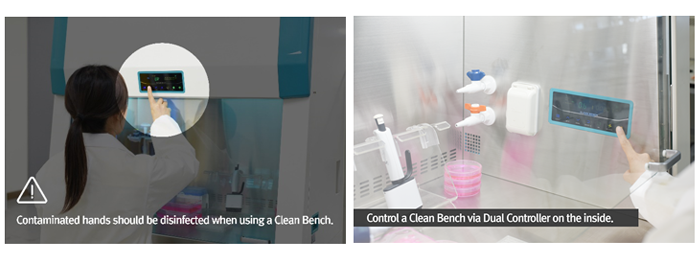
Lab Companion's Clean Bench can be operated without the risk of cross-contamination or turbulence formation, as it can operate internal controllers without putting hands out during the experiment through dual controllers equipped on the outside and the inside of the device. Also, the temperature and humidity required for recording the experimental conditions can be checked in real-time, which is not cumbersome and makes it very convenient to use.
Q, Are there any precautions when using UV lamps necessary for sterilization?
A, Clean Bench has ultraviolet (UV) sterilization function, but UV is classified as a group 1 carcinogen by IARC, an international cancer research institute, so care must be taken not to irradiate UV to the experimenter. If the experimenter opens the door when the UV lamp stays in turning on, then the experimenter is exposed to UV light so may be injured.
In particular, the short-wavelength used in sterilizing lamps is reported to destroy DNA and cause skin cancer. In addition to carcinogenicity, UV rays can damage the skin, eyes, and immune system, and cause various dangerous eye diseases such as corneal damage, cataracts, and macular degeneration.
However, even if you are aware of these precautions while experimenting, you may inadvertently open the door when the UV Lamp is operating. Also, you may put your hands in not realizing the UV Lamp is on. To prevent this dangerous situation, the Clean Bench of Lab Companion considers the safety of users as the top priority, so automatically turns off the UV when the door is opened while the UV Lamp is in operation. Also to prevent internal recontamination before use, it immediately activates the blowers at the same time as UV lights and turns on fluorescent lights to complete the preparation for the experiment. (Smart Door System Registration 10-1451382)
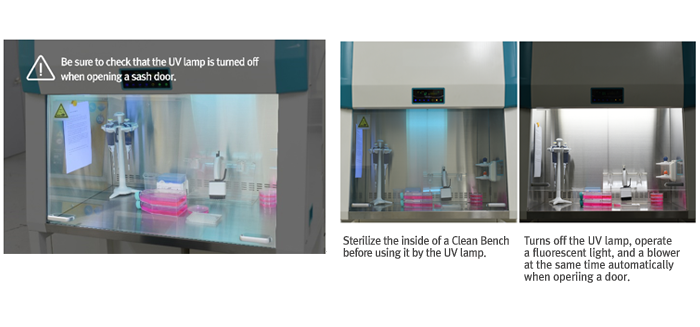 - Q, I need some notes, scissors, knives, etc. to record during the experiment, can I leave them inside?
A, Only sterilized items can be placed on the testing bench, and only essential items must be placed inside the Clean Bench to avoid obstructing the airflow. Necessary items must be sterilized before placing them on the workbench. However, in the case of a large-sized object, it might obstruct a flow of clean air passing through the inside to the sash for going out, or occur the flowing backward of the external air from the outside.
It is available to place the sterilized object inside, but it is recommended to place it as far away from the sample to prevent cross-contamination in case.
The interior of Lab Companion’s Clean Bench is made of SUS material for cleanliness and corrosion resistance, but the inner wall of the left side is made of magnetic board, which allows experiment protocol or simple memo paper or tool to be fixed with a magnet, making it easy to arrange the inside.
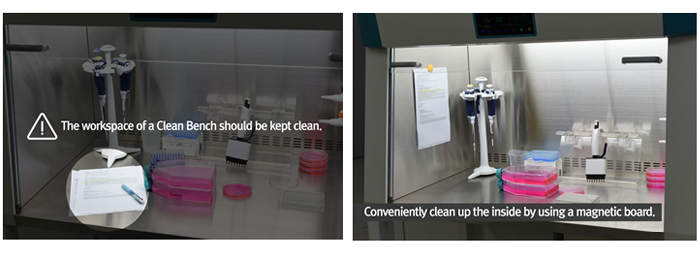
- Q,How do I check the filter change timing and validation of the Clean Bench?
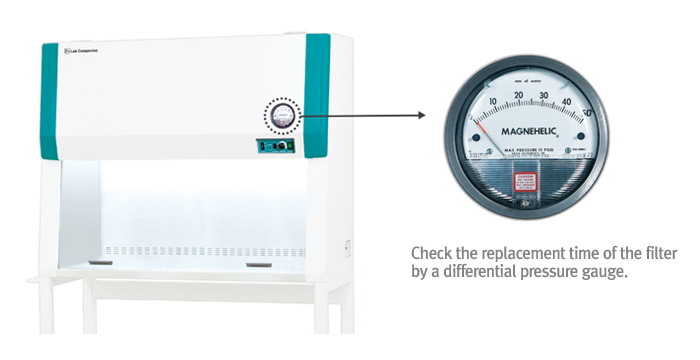
A, HEPA filter is the most essential part of the Clean Bench, so it is important to replace the new one for its performance at the right time. But due to various factors such as the frequency of usage and laboratory environment, the life span is very different, so it may be hard to determine when to replace it. The life of the filter usually varies depending on the cleanliness of the laboratory, but it is about 10,000 hours. And the HEPA filter is fragile, so care must be taken not to damage the surface of the filter. If the surface is damaged, stop using it immediately and replace the filter or do a performance test.
If a differential pressure gauge is installed on the Clean Bench, you can check the filter replacement time by monitoring periodically the air pressure in the filter. As the usage time of the HEPA filter elapses, fine floating dust and pollutants in the air accumulate gradually between the filters, reducing the amount of air passing through the filter. Therefore, the difference in wind pressure gets an increase between the top and bottom of the filter, and the differential pressure increases.
To check the replacement timing, adjust the differential pressure gauge to the zero point when the device is off. Then, open the door of the Clean Bench about 20 cm, operate the blower at maximum speed, and measure the differential pressure. If the measured pressure is increased by more 25mmH₂O than the initial differential pressure, the filter has reached the end of its life and the filter should be replaced.

BC-H of Lab Companion’s Clean Bench has a digital differential pressure sensor that measures the differential pressure of the HEPA filter automatically to check its performance. When the differential pressure of the HEPA filter is over 25mmAq during the operation, ‘Warning’ light on the controller flickers to inform the replacement timing, so there is no need to worry about the filter replacement cycle anymore. Besides, the filter change is convenient and simple by applying the cartridge type for the filter.
All equipment should be taken periodic validation. However, since the filter is inside of the equipment, it may take a long time to dismantle the equipment when performing validation and it may be difficult to work. So it is designed with a convenient structure to perform all maintenance and inspections at the front of the device to facilitate periodic Validation. In particular, the inlet of the GAS (DOP/PAO, etc.) for HEPA filter performance testing is provided separately on the front side, allowing easy Validation.
Tip!
Apart from checking the differential pressure of the HEPA filter, a Particle Count Test should be performed every half year. And Validation such as wind speed test and Leakage Test should be performed periodically every year
So far, we have looked at some of the inconveniences and questions about using Clean Bench.
Join 'Lab Companion' - who always thinks about the safety of the experimenter first!
Thank you.
|



